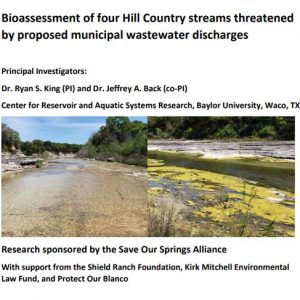Bioassessment of four Hill Country streams threatened by proposed municipal wastewater discharges

The investigators were charged with completing a comprehensive biological assessment of four (4) Hill Country streams that were subject to permit applications for wastewater treatment plant (WWTP) effluent discharges. The four streams included Onion Creek, Blanco River, Honey Creek, and Barton Creek. Sampling occurred during late spring (high base flows) and late summer (low flows) of 2019. Each stream was sampled above and below proposed locations of WWTP effluent discharges. Locations were selected with the cooperation of Save Our Springs Alliance and landowners. Thus, a total of eight (8) stream reaches (defined stretches of streams with defined upstream and downstream locations) were sampled two (2) times each, or the equivalent of sampling 16 stream reaches during the period of performance.
Each reach was sampled in accordance with current Texas Commission on Environmental Quality (TCEQ) biological assessment protocols. Biological assemblages, or community types, sampled were as follows:
-
- Periphyton and macroalgae (high and low flow)
- Benthic macroinvertebrates (high and low flow)
- Fish (critical flow period, late summer, per TCEQ guidelines)
Further, discharge, surface-water chemistry (temperature, dissolved oxygen, specific conductance, pH, turbidity, dissolved inorganic phosphorus (PO4-P), total phosphorus (TP), ammonium-nitrogen (NH4-N), nitrate-nitrite-N (NOx-N), and total N (TN) were sampled and analyzed at least two times from each reach during the study period. Finally, YSI EXO1 datasondes were deployed at each stream during high and low flow periods to estimate instantaneous changes in dissolved oxygen, pH, conductivity, and temperature at 15-minute intervals over at least a 24 h period.
The following is the final report summarizing results in accordance with the scope of work and services agreement (#32030263).
Conclusions
All four of these Hill Country streams are vulnerable to nutrient enrichment. In the cases of the three streams where the reach upstream was above the input of existing and potential wastewater inputs (all but Honey Creek), these reaches had ambient nutrient levels indicative of a low-nutrient, pristine to nearly pristine Hill Country ecosystem. However, in two of these three cases, the lower reach (Blanco River and Onion Creek) already had signs of wastewater pollution.
The Blanco River at Blanco Settlement, in particular, was already impacted by sources of nutrients that were not detected above the city of Blanco. Multiple indicators (dissolved and total phosphorus concentrations, sestonic chlorophyll-a and total suspended solids, 24-hour changes in dissolved oxygen, algal biomass, stable isotopes of nitrogen in algae, nuisance algal biovolume, diatom species composition, macroinvertebrate densities, macroinvertebrate species composition, and fish species densities) all suggested that the Blanco River at Blanco Settlement was impacted already by wastewater.
Onion Creek at CharRo Ranch had fewer indicators of wastewater impacts than Blanco Settlement, but it appears to be in the early stages of eutrophication from excessive nutrient inputs. Nutrients trended higher during certain flow regimes, especially low flow, as did stable nitrogen isotopes, which are one of the most sensitive early-warning signals of external wastewater nutrient sources. Of further concern is the tendency for the lower reach to dry up into a series of pools during low flow, which leaves it even more vulnerable to nutrient enrichment.
Barton Creek may have some influence of wastewater from the upstream catchment, as evidenced by slightly elevated nitrogen isotopes in the periphyton, but there were no clear differences between the upstream and downstream reaches as they relate to Long Branch, the tributary proposed to be the conduit for wastewater into Barton Creek on Shield Ranch. Currently, Barton Creek at Shield Ranch has relatively high-water quality and algal, macroinvertebrate, and fish assemblages typical of a reference-caliber Hill-Country stream.
Finally, Honey Creek, arguably the most unique and special of these four streams, had differences between the upstream and downstream reach that were likely mostly related to the amount of groundwater feeding into the stream, with the upper reach being just downstream of the first major spring, and the downstream reach being downstream of one or several more larger springs. The lower reach had much higher flows, but also higher levels of nitrogen, potentially indicative of groundwater contamination. Both reaches had higher-than-expected nitrogen concentrations and are highly vulnerable to any additional nutrient enrichment, especially phosphorus, given the already elevated levels of nitrogen.